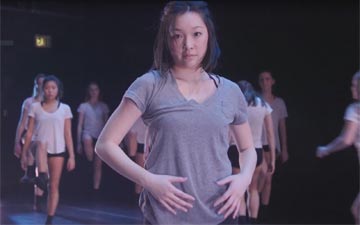
Student project on Buck v. Bell
Student choreographer Natalie Duong leads a dance piece on the Supreme Court case Buck v. Bell
While most people expect ethical reflection on a social issue to take the form of a discussion, for Natalie Duong, an SCU senior majoring in bioengineering and minoring in dance, that reflection happened through movement. A student in Center Associate Director Margaret McLean’s “Ethics in the Health Professions” course, Duong choreographed a dance exploring the issues raised by the 1927 Supreme Court decision Buck v. Bell, which upheld sterilization for the so-called “feeble-minded.” For this honors project, she used music composed by SCU Director of Choral Activities Scot Hanna-Weir. (Read more about the piece.) Her observations on the project follow.
Arts for Social Justice seeks to inform, promote discussion, and/or encourage action for a particular issue in society. Through the art of dance, I have had the opportunity to explore the ethical issues of Buck v. Bell (1927) regarding the forced sterilization of the “feebleminded.” There are plenty of ethical concerns surrounding the case to address. In my choreography, I specifically focused on the societal labeling and discrimination against the mentally disabled and the violation of individual rights for the public welfare.
Society’s definition of “mentally disabled” has changed and developed over time and may still be subject to change, which is why it is important to reflect on whom we label as “mentally disabled” and how we treat them. For example, during the time period in which this case took place, those with loose moral conduct were often considered “feebleminded,” which is why both Carrie Buck and her mother were institutionalized after having children out of wedlock. This is a very nonscientific and arbitrary guideline for determining mental disability, and it is no longer used. Thus, in the dance, the societal labeling of mental disability is represented by the removal of a white shirt and its replacement with a gray shirt. This changing of clothing demonstrates how identifying an individual as different can be very exposing and intrude into his/her privacy.
This case was a clear violation of Carrie Buck’s rights to autonomy, reproduction, and nonmaleficence motivated by an attempt to promote the public welfare through eugenics. This is a dangerous shift from traditional values of family life, reproduction, and individual rights to values of a purely social kind. This case is not the only case in which the government has restricted individual rights for the promotion of the public welfare in a very ethically concerning way, and we still have to be wary of any similar situations. Thus, this is a major focus of my dance as it is entitled, “It is better for all the world…”, a quote from Justice Oliver Wendell Holmes’ decision on the Buck v. Bell case which demonstrates this emphasis on the public welfare over individual rights. This overemphasis on the welfare of society is portrayed by static, almost militaristic, and repetitive marching throughout the dance piece.
I hope that this piece, set to Professor Scot Hanna-Weir’s musical composition, “Buck v Bell,” will promote discussion and reflection on past, present, and future violations of human rights by an institution for the supposed public welfare.
The video of "It is better for all the world" was shot by SCU student Rhonda Teeny.
